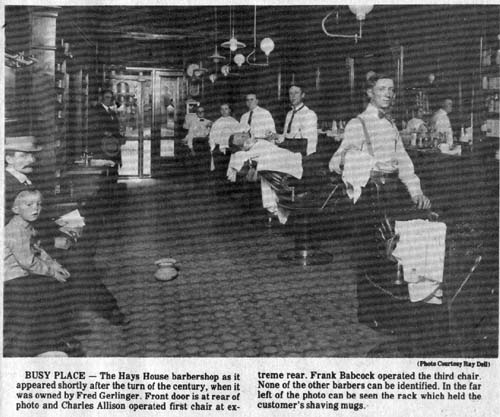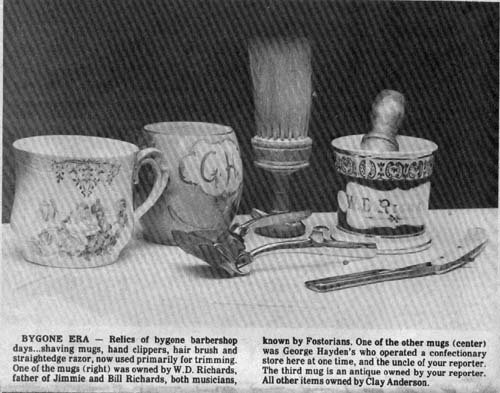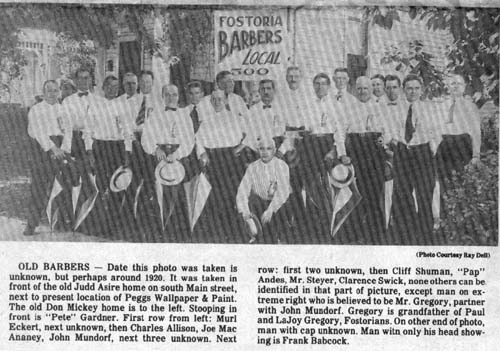March 30, 1977



Picture #1 – Busy Place – The Hays House barbershop as it appeared shortly after the turn of the century, when it was owned by Fred Gerlinger. Front door is at rear of photo and Charles Allison operated first chair at extreme rear. Frank Babcock operated the third chair. None of the other barbers can be identified. In the far left of the photo can be seen the rack which held the customer’s shaving mugs.
Picture #2 – Bygone Era – Relics of bygone barbershop days …shaving mugs, hand clippers, hair brush and straightedge razor, now used primarily for trimming. One of the mugs (right) was owned by W.D. Richards, father of Jimmie and Bill Richards, both musicians, know by Fostorians. One of the other mugs (center) was George Hayden’s who operated a confectionary store here at one time, and the uncle of your reporter. The third mug is an antique owned by your reporter. All other items owned by Clay Anderson.
Picture #3 – Old Barbers – Date this photo was taken is unknown, but perhaps around 1920. It was taken in front of the old Judd Asire home on south Main Street, next to present location of Peggs Wallpaper & Paint. The old Don Mickey home is to the left. Stooping in front is “Pete” Gardner. First row from left: Murl Eckert, next unknown, then Charles Allison, Joe Mac Ananey, John Mundorf, next three unknown. Next row: first two unknown, then Cliff Shuman, “Pap” Andes, Mr. Steyer, Clarence Swick, none others can be identified in that part of the picture, excep man on extreme right who is
believed to be Mr. Gregory, partner with John Mundorf. Gregory is grandfather of Paul and LaJoy Gregory, Fostorians. On other end of photo, man with cap unknown. Man with only his head showing is Frank Babcock.
Picture #4 (missing) – Clay Anderson
This is a changing world. Everything has changed in the last 50-75 years – eating habits, travel habits, education, transportation, clothes …and so on and on we could go. Also include barbering habits and barber shops.
And now another change has taken place – Clay Anderson of the Two Guys has quit the barber business after being actively engaged in it for more than 50 years.
Anderson started when he was still in high school in Arlington, Ohio. In an interview with “Clay”, as he is generally referred to in Fostoria, he reminisced freely about how he got started and about some good memories.
“Way back there”, he recalled, “when I was still in high school. I would go into the shop on Saturday and do some haircuts and shaves, then leave in time to play on the Arlington High football team in the afternoon. I remember coming to Fostoria to play against St. Wendelin when Cy Scharf was coach and Phil Degan was on their team. We won.
I barbered three years, part-time, while still going to school.
When Clay came to Fostoria in 1927, he went to work at Oscar Daymude’s Barber Shop and Beauty Parlor, which was in the basement of the Alcott Block at the corner of Center and Main. Clay and Daymude did the barbering and Mrs. Daymude and Katherine Miller handled the ladies’ department. In those days beauty shop work consisted primarily of marcelling, and finger waving ladies’ hair – permanents and all the other services performed in present day beauty shops hadn’t come into vogue yet.
An interesting sidelight concerns the customer Clay serviced the longest – Lester Van Sant. Van Sant was a freshman at Arlington High when Clay was a senior and Clay cut his hair until left and came to Fostoria.
Then when Van Sant was teaching and coaching at Risingsun he again became Clay’s customer and continued when he moved to Fostoria and started teaching here.
Changes, changes, changes as I was saying. When I was a boy, Fostoria was a Saturday night town. The uptown streets were so crowded it was difficult to make your way down the sidewalks and from store to store.
The townspeople went up town, and the farmfolk came to town – and the barbershops were crowded with menfolk who wanted to get fixed up for Sunday. Barbershops hours, then, on Saturday night, usually lengthened until all the customers were worked out, which was often 11 p.m.
Time in the barber chair wasn’t the traditional 20 minutes of today and for good reasons. In the first place, hand clippers, not electric, were in vogue then and they slowed-up the cutting time. Also, the safety razor hadn’t been invented yet, and many men were shaved at the barbershop.
So, when a man climbed in the barber chair he more often than not wanted a shave, haircut, and maybe a wash. So, that was about a one-hour treatment.
Barbershops had shaving mug racks, where regular customers had their own mug, used exclusively for them. The mugs were highly decorated and initialled for owner identification. Today those mugs are treasured as family heirlooms and antiques.
Those men who shaved themselves had to be brave and adept at using the common straightedge razor, the best ones being of German make.
Unlike today, every boy and man visited the barbershop on a regular basis then, which naturally created a demand for more barbers and shops to handle the business. It was estimated that Fostoria supported approximately 25 shops and perhaps 40-50 barbers then.
Clay reminded me that one time there were six shops on east Center alone, in the one-half block from Main Street. William Oliver was in the basement of the First National Bank. T.O. Lee was in a frame building further east and Anderson was in the Sherwood Hotel.
On the other side of the street Daymude was in the basement at the corner of Main. Cliff Shuman was further east and Willard Smith was in the basement of the building now occupied by The Review Times – under their mechanical department.
Clay Anderson started his own barber shop in the Sherwood Hotel on east Center and remained ther for 25 years, until the building was demolished. Then he became associated with the B&J shop across the street, where the Colonial Beauty Inn is now located. John Bowman was associated with the B&J too and they later joined-up to form the Two Guys shop in the location on east Center where Cliff Shuman had a babershop, In fact that location had been a barbershop continuously for many years, operated by various barbers, including John Mundorf and “Red” Gregory, Walt Boyher, Henry Myers; perhaps others who’s names are not recalled.
So now the Two Guys shop at 333 North Main, where Clay and John Bowman have been partners for so many years has become another one-man shop.
Another factor has contributed to the reduction of the number of barbershops, and that is the extension of the work done by beauty parlors. For many years after girls and women started to wear short hair, their work was done exclusively in the barbershop a practice which initially men disliked very much since they could not talk so freely. Furthermore, the females were invading a domain the men considered their own. But gradually, the beauty shops took on the cutting and styling of ladies’ hair and today do most of it, but there are a few who still prefer to have barbers to it.
You will remember the expression “his hair looked like is pa had cut it with a crock over his head”, and for those who couldn’t afford a professional haircut, that probably happened – at least something was put on the head to serve as a guide.
The largest barbershop in Fostoria back 50 years or more was the Hays House, in the hotel by the same name. For those too young to remember, or for newcomers to town, it was in the area uptown where the parking lot is located, next to Bill’s Mens Store. That block burned out in 1962 (May 19) and was eventually demolished.
The Hays House Barber Shop in its heyday had five chairs. It’s business volume was boosted by the large number of traveling men who frequented Fostoria then, and stayed at the adjoining hotel.
The first owner of the barber shop was Fred Gerlinger. He began his business there on Nov. 23, 1898, with just three chairs and gradually expanded it. Later, he sold out to John Heldt and entered the appliance business with his son Rudolph in part of the A.C. Hoyt Building on west North Street .
Some of the barbers that I remember who worked at the Hays House in addition to Gerlinger and Heldt, were Joe McAnaney, Charles Allison, Pet Gardner, Murl Eckert, Mr. Bernard,, my uncle Frank Babcock and my father George Krupp.
Clarence Swick, at the age of 80, is the oldest practicing barber in Fostoria, and told your reporter, that he started in 1921, which makes 56 years he has been handling the scissors, clippers and razor. He has practiced his trade at various locations, but for many years has been on South Main Street next to Firestone.
Today, there are only seven barber shops left in Fostoria – five of them being one-man shops. The barbers are John Bowman, Larry Hahn, Bob Horner, Harry Swartz, Cliff Emahiser, Mel Shultz, Clarence Swick, John Waltermire, Pam Williams, Charles Snyder, Henry Gloria.
So the question is – who cut your hair and how many of these barbers can you remember? They all barbered here in days gone by:
Henry Myers, Cliff Shuman, John Mundorf, Mr. Gregory, Steve Hite, Barney Hite, Charles Few, Oscar Daymude, T.O. Lee, Russell Smith, Herb Coffman, Tom Dillon, William Oliver, Ray Burson, Alan Anderson, Harry Swartz, Bob Balderson, Murl Eckert, Mervin Rose, Arnold Rose, Frank Babcock, George Krupp, Al Andes, Pat Andes, Fred Howard, Cliff Stocker, Jake Schlenker, Ray Cable, Charles Allison, John Heldt, Fred LaRue, Walt Boyher, Ken Frankhart, Tom Montgomery and Pete Kitzer.
George Droll, Joe Droll, “Red” Gooddale, Ross Goodman, “Dutch” Crowe, Bus Seebon, Burt McKenzie, Ken Beman, Harold Bentz, Fred Pratt, Chet Martin, Clarence Gregory, Jack Sheets, Wayne McAlevy, Willis Sprague, Leo Reinhart, Jim Buckner, Park Stouffer, Clayton “Slim” Shingledecker, Charles Beamer, “Hap” Brightner, Irs Johnson, John Waltermire, Pam Williams, Charles Snyder, Henry Gloria, Ralph and Martha Beamer, Claire Shane, Dave Davis, Rell Horner, Dale Scott, Dan Mealy, “Kuhnie” Kuhn. (Sorry if I missed any).